This Kala Vatana Usal, also fondly known as the Kala Vatana Sambar or Kalya Vatanyachi Usal is one of those really comforting vegetarian dishes from Malvani cuisine. It is one of the key preparations that is offered as a ‘prasad’ or ‘naivedya’ (sans onion and garlic) to Bhagwan Ganesha during the auspicious Ganesh Chaturthi festival.
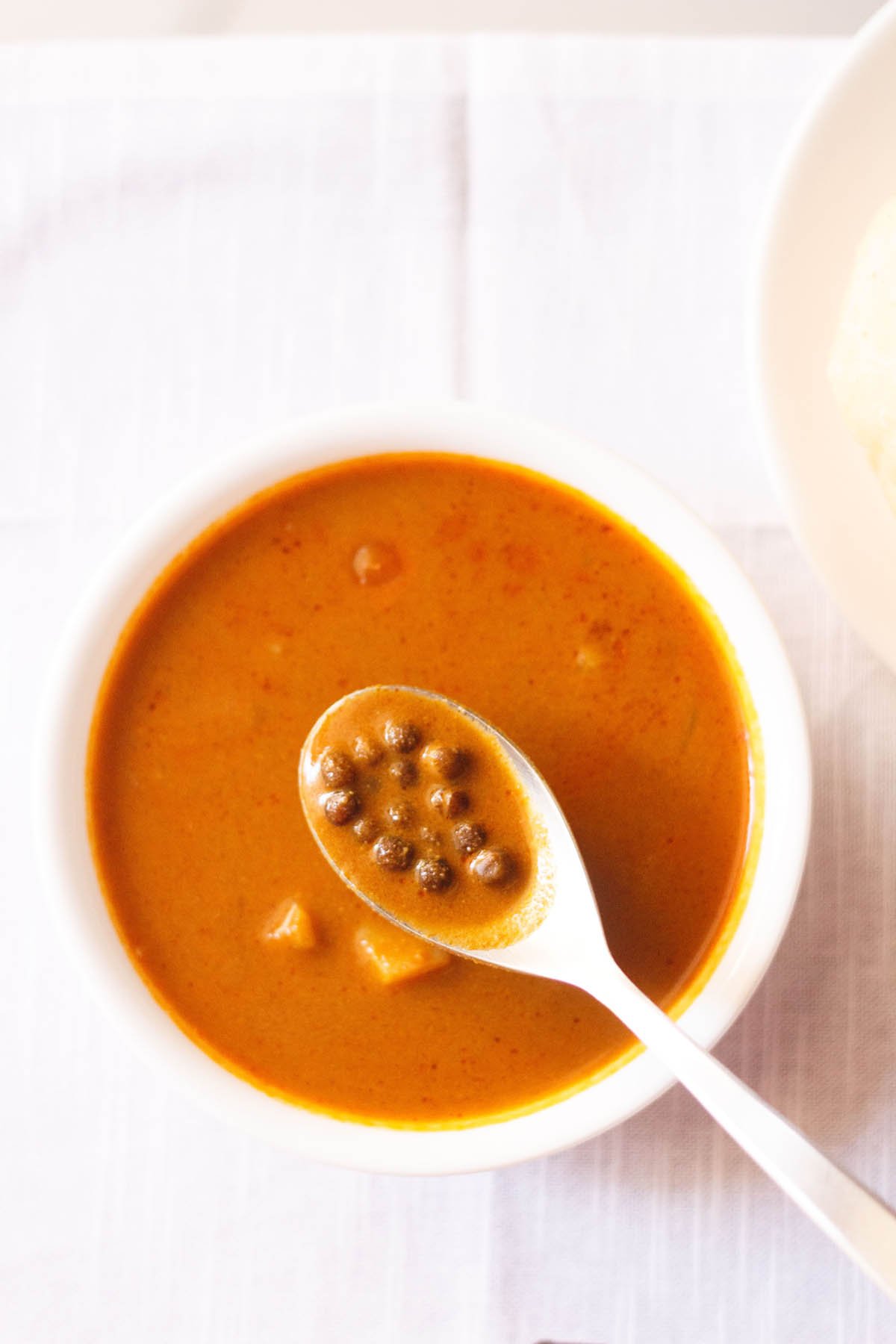
Table of Contents
About Malvani Cuisine
The South Konkan areas of Maharashtra and Goa basically form the Malvan region, also the home of the rich Malvani cuisine. So, obviously there is an influence of both Maharashtrian and Goan cuisines as well in this independent food culture.
Some noted features of the Malvani cuisine include the generous use of coconut in varied forms – from fresh coconut and dried desiccated coconut to coconut milk and paste as well; use of dried red chilies, ginger, garlic and other spices. All these essentially make this cuisine a robust one.
However, Malvani cuisine also uses souring agents like kokum, raw green mango and tamarind to balance the heat or spiciness. For instance, one of the sub styles in this cuisine practiced by the Konkanastha Brahmin community have a less spicy food culture.
Just like this Kala Vatana Usal, many other Malvani preparations use a typical spice mix called the Malvani masala powder. Traditionally, it is made with about 18 to 20 dried spices which are finely ground.
In addition to this Kalya Vatanyachi Usal or Malvani style Black Peas Sambar, other famous vegetarian dishes of the Malvani and Konkani cuisine that I have shared is the pink-hued tangy Solkadhi, healthy Chawli Bhaji & Padwal Bhaji, crispy Suran Fry, festive Rishi Panchami Bhaji and sweet rice flour roll Patholi.
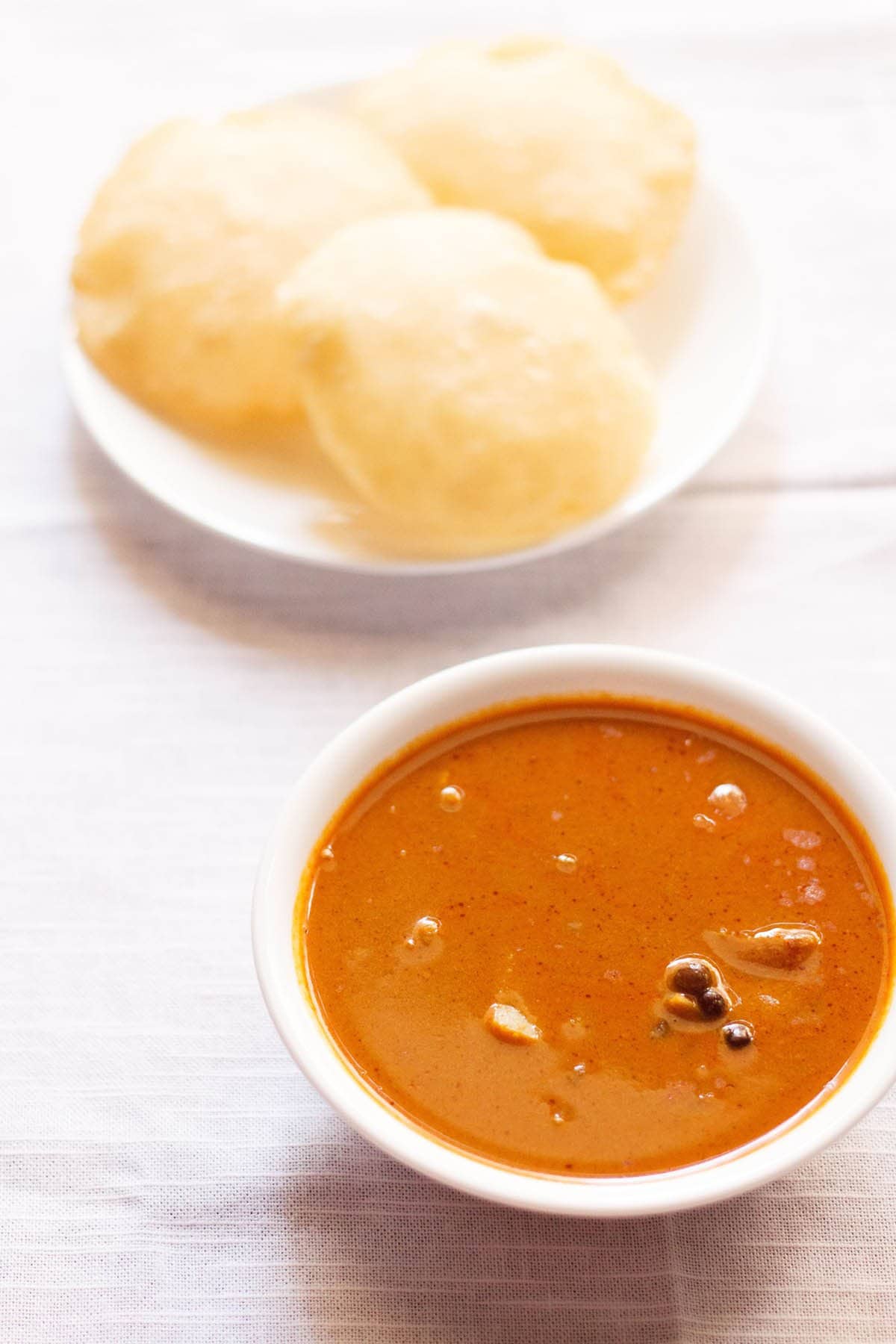
Kala Vatana Usal
This authentic Kala Vatana Usal is my mother’s recipe from her prized collection. She used to make it quite often as I was growing up. So, even I’ve developed a liking for this dish over the years.
Not to forget, it is an absolute favorite legume dish of our family. We also love Modak and whenever I make these sweet dumplings at home, they disappear soon.
Also, this Kala Vatana Sambar is not your usual South Indian Sambar. It comes really close to the Maharashtrian Usal. Hence, also termed as Kala Vatana Usal. But whatever you may call it, the dish is awesome in flavors, texture and aroma. A must try!
At my ‘aai’ or mother’s place, we relish the Kala Vatana Sambar with vade. Not to confuse with the South Indian Medu Vada, the Maharashtrian/Malvani Vade is a fried puffed flatbread (just like a poori) essentially made with rice flour or a mix of few flours.
Readymade vade flour is also available in Mumbai and Pune, and it can be made at home too. Of course, the homemade version is much better and always preferred by me.
More on the recipe
As obvious from the name Kala Vatana Sambar, the main ingredient of this dish is the kala vatana, which is dried black peas. Though termed black, this legume is not really black in color, but has a brownish-black tinge. Don’t confuse it with black eyed beans or black beans.
This Kalya Vatanyachi Usal recipe also has the Malvani masala as an important element. Haven’t been able to store it at home? No issues, you still can make the dish. There are a few extra spices that you must roast along with the other masala ingredients and also add the garam masala powder. Details in the below section.
While I always like pairing this Kala Vatana Usal with the vade, it also tastes supreme with plain poori, steamed rice or even jeera rice.
If you don’t have Malvani masala
After sautéing the ginger and garlic as shown in the steps below, add the whole spices listed below and roast for a couple of seconds. Do this before you add the coconut.
- 1 teaspoon fennel seeds (saunf)
- 1 thin single strand of mace (javitri)
- 1 small stone flower (dagad phool)
- 1 small star anise (chakri phool)
- 1 teaspoon poppy seeds (khus khus)
- 1 cobra saffron (nagkesar), optional
- 1 sichuan pepper or triphal, optional
You also have to add 1 teaspoon of Garam Masala powder. This can be added directly while the Kala Vatana Sambar is simmering.
However, I would always recommend you to store the Malvani masala at home because the flavor profile really is unique when this spice mix is used in its truest element.
Note: If you do plan to make the delish curry for the Ganesh Chaturthi festival, then omit adding onions and garlic.
How to make Kala Vatana Usal
Preparation
1. Start the previous night. Pick and clean 1 cup of dried black peas or kala vatana. Wash the peas 3 to 4 times in running water.
Soak the black peas in enough water for 8 to 10 hours. You can also use sprouted black peas.
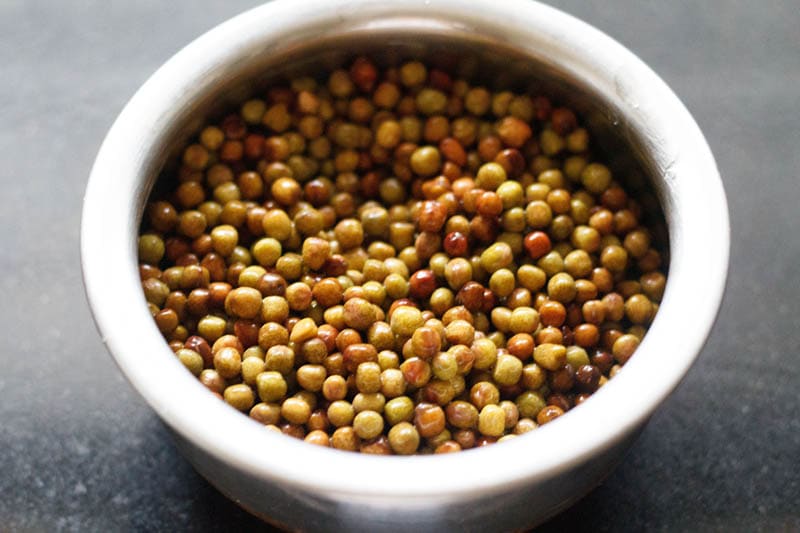
2. The next day, discard the water from the soaked black peas and rinse with fresh water a few times.
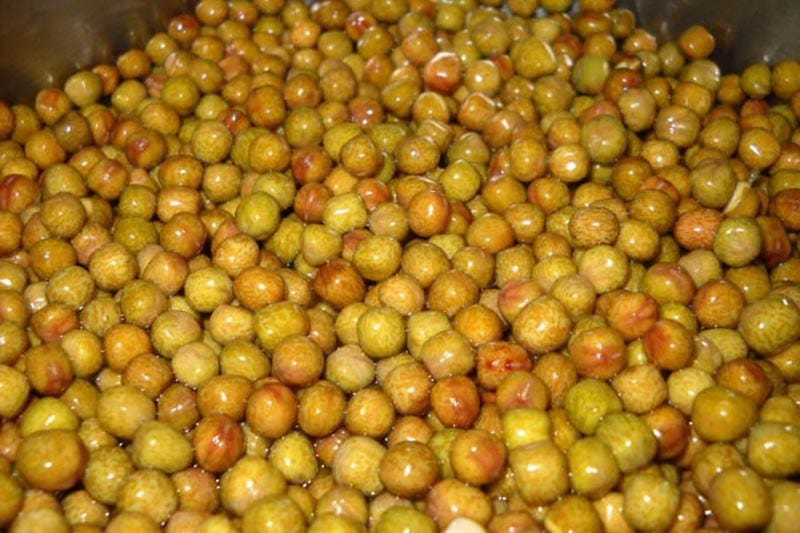
3. Boil the soaked kala vatana with salt and 2 cups water and ½ teaspoon salt in a 3-litre pressure cooker on medium heat for 10 to 12 minutes or till they are completely cooked and tender.
The peas should soften nicely. Drain the water from the cooked peas in a strainer.
Note that the cooking time will vary with the quality and age of the peas. Use dried black peas that are within their expiry date.
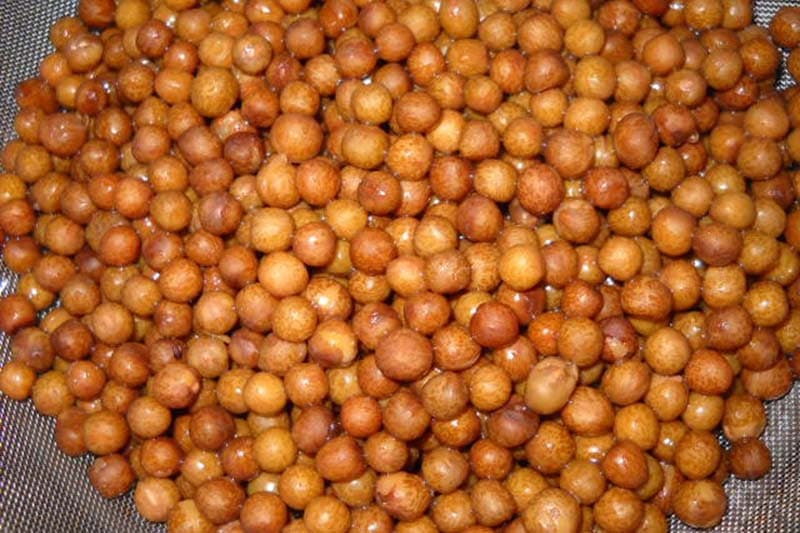
Make Masala Paste
4. Heat 1 tablespoon oil on a tawa or frying pan. Add half portion of 1 medium-sized onion (about ⅓ cup sliced onions) that has been sliced thinly. Sauté the onions till light golden.
Add the 5 to 6 chopped garlic cloves (small to medium-sized) and 1 inch peeled and chopped ginger, and sauté for a few seconds.
Next add in 1 cup grated fresh coconut or a mix of ½ cup fresh coconut and ¼ cup desiccated coconut. Mix and roast for a minute.
Add 1 to 2 dried red chilies. Remove seeds from the chillies if you prefer.
Roast the coconut mixture on low heat stirring often till the coconut becomes golden. Keep stirring so that the masala mixture does not get burnt.
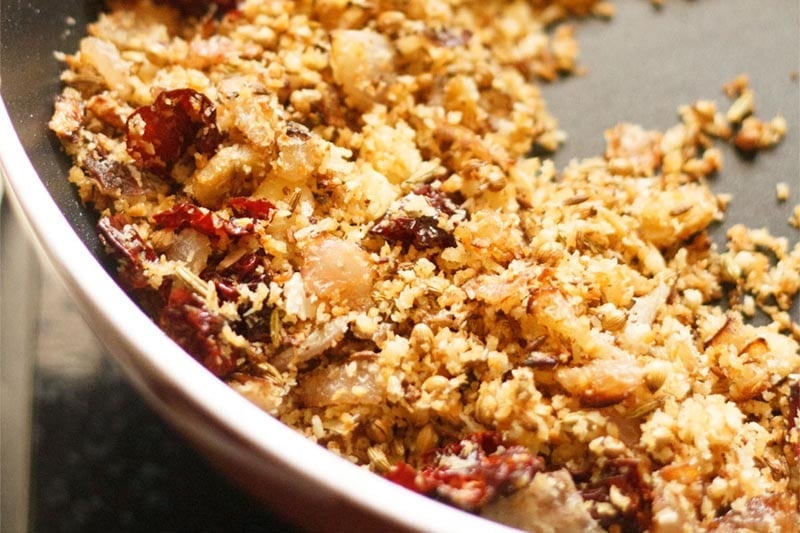
5. Once the coconut has become golden, set aside the masala mixture to cool. Once cooled, add the coconut masala mixture in a grinder. Add 2 to 3 tablespoons of the boiled kala vatana to it.
Add ⅓ to ½ cup water and grind to a smooth fine paste. Add more water if needed when grinding or blending.
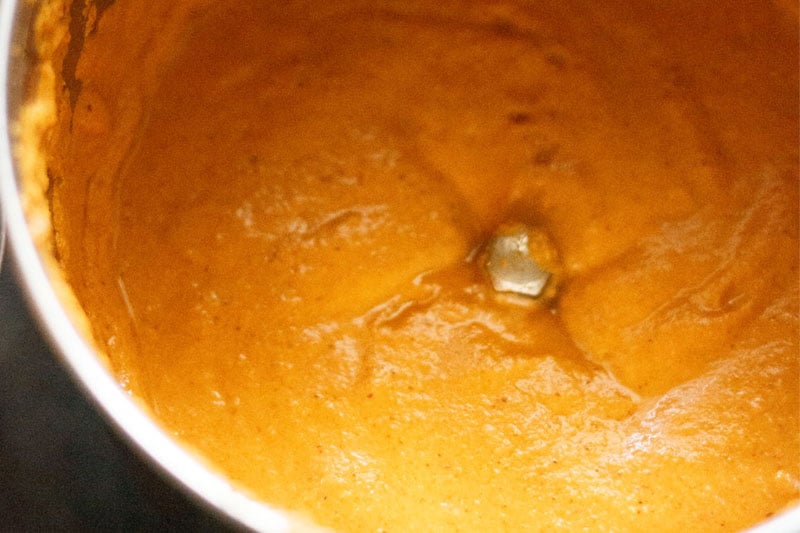
Make Kala Vatana Sambar
6. Now, heat 2 tablespoons oil in another deep-bottomed pan. Sauté ⅓ cup of chopped onions till translucent. The onions should soften.
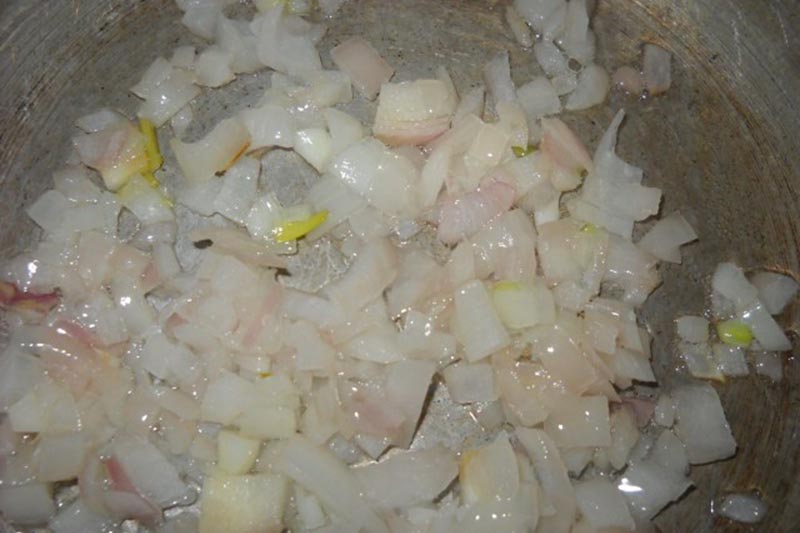
7. Add ½ teaspoon turmeric powder and 1 to 1.5 tablespoons Malvani masala.
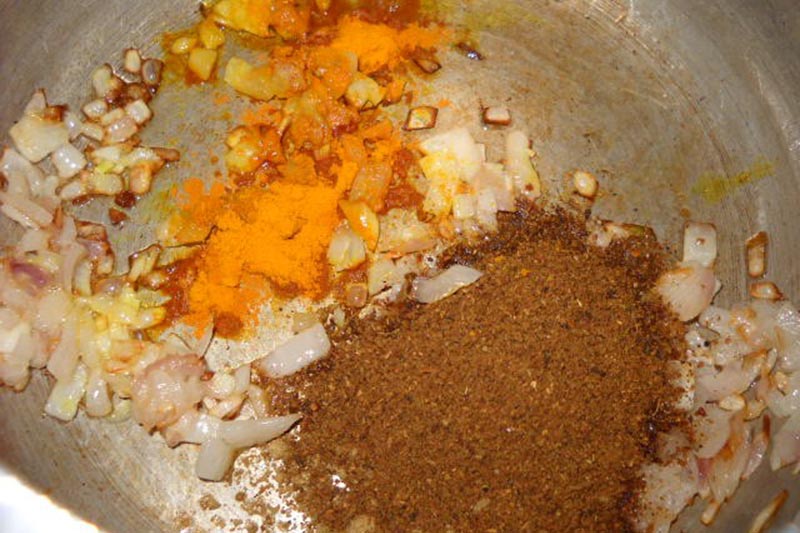
8. Add the prepared masala paste. Now, you can add 1 chopped tomato (small-sized) as well.
Mix well and cook the mixture for 2 minutes on low heat. The masala splutters, so keep stirring it.
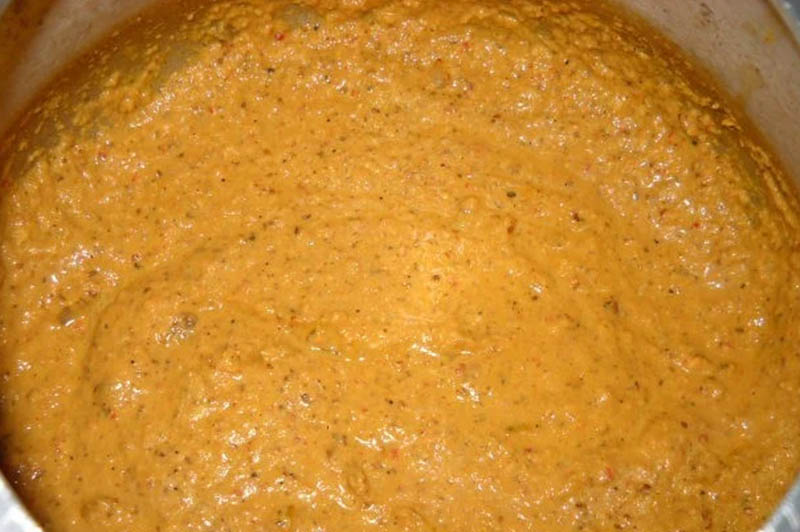
9. Add 1 or 1.5 cups of water or more (depending on the consistency you want) in the curry. But do not make the curry too thin or runny.
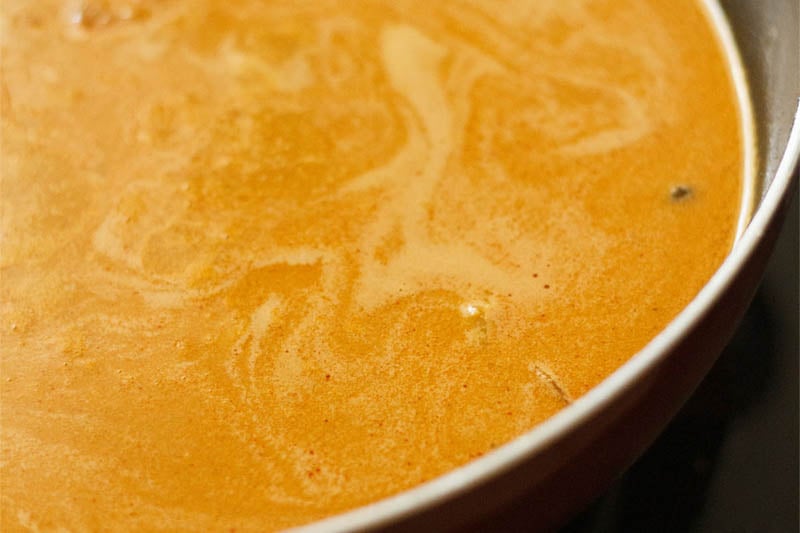
10. Bring the curry to a boil first. Then, lower the heat and simmer for 5 to 7 minutes further. Take care that the usal does not spill while boiling.
Make it as per your choice of consistency. If you like more curry, add some more water. Check the taste and add more salt, if required.
Once the curry is cooked perfectly, you will see some oil specks floating on the top layer of the curry. Lastly add 1 to 2 tablespoon of chopped coriander leaves.
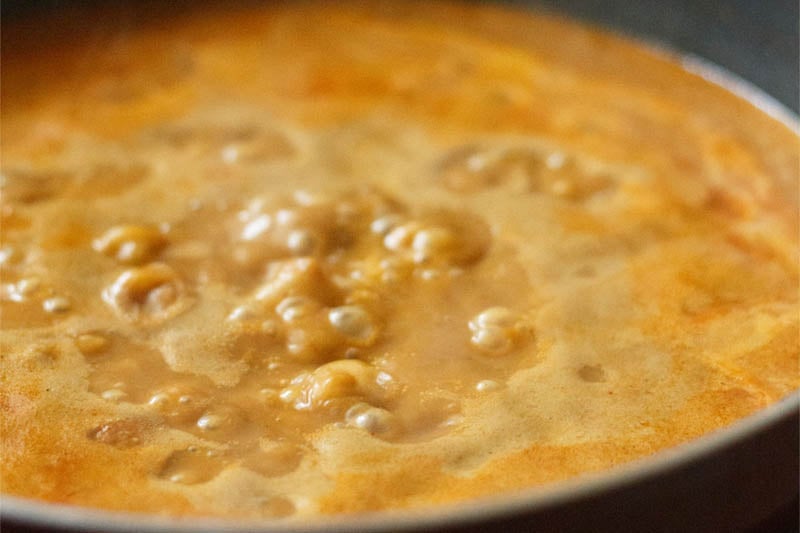
11. Serve Kala Vatana Sambar hot or warm with Rice Vada or regular Poori or Malwani Vade. You can also pair Kala Vatana Usal with steamed rice.
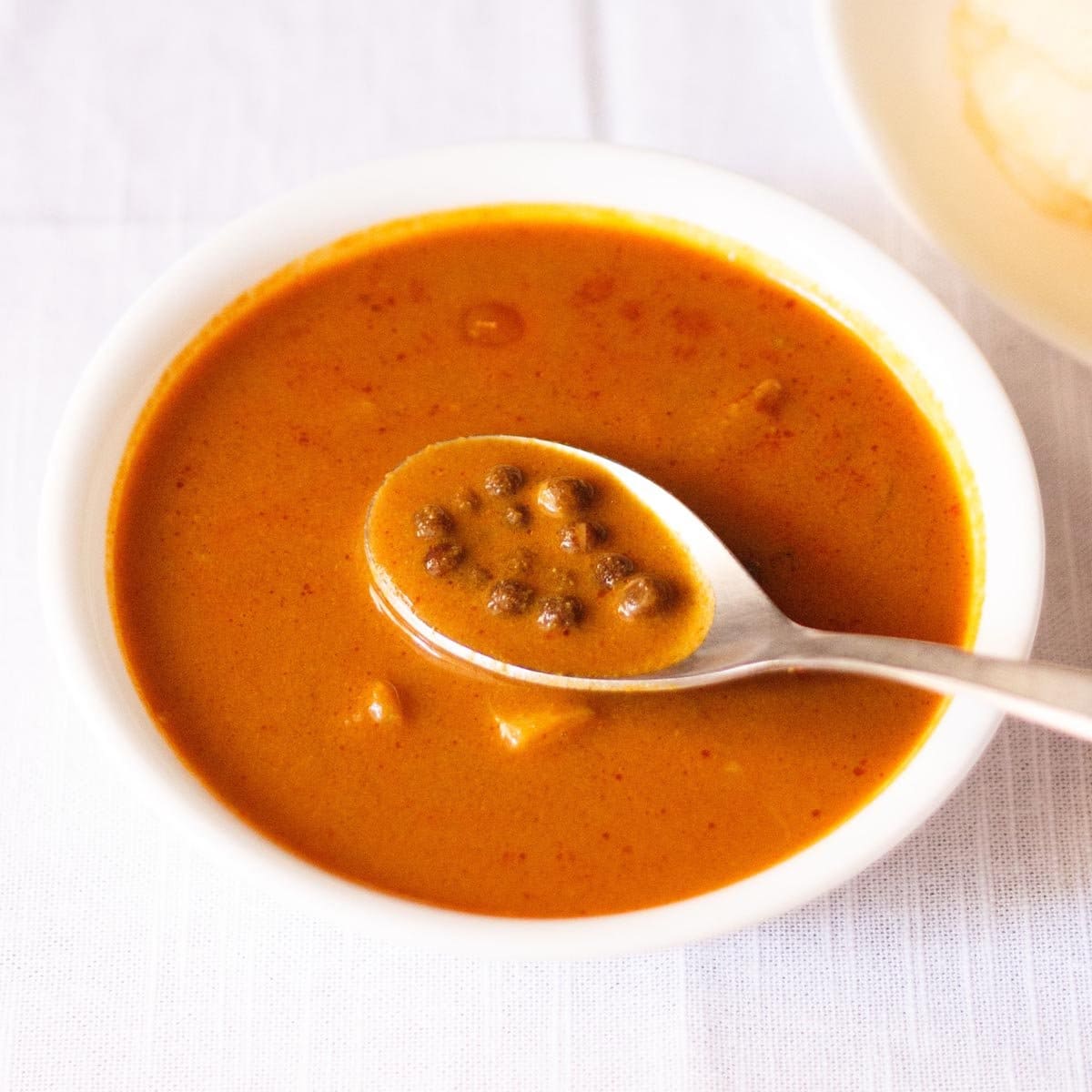
More Lentil Curry Recipes To Try!
Dal (Lentils) & Legumes
Kerala Recipes
Dal (Lentils) & Legumes
Dal (Lentils) & Legumes
Please be sure to rate the recipe in the recipe card or leave a comment below if you have made it. For more vegetarian inspirations, Sign Up for my emails or follow me on Instagram, Youtube, Facebook, Pinterest or Twitter.
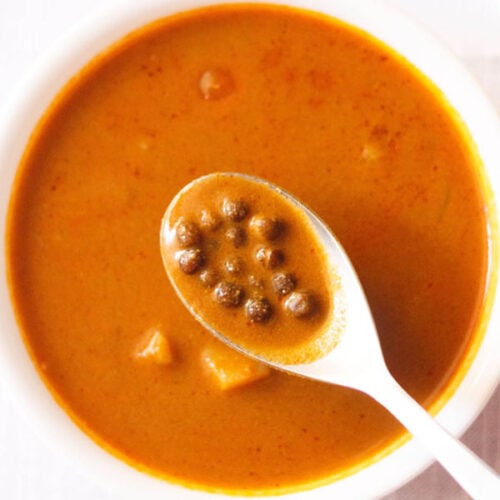
Kala Vatana Usal (Kalya Vatanyachi Usal)
Ingredients
For cooking black peas
- 1 cup black peas (kala vatana)
- 2 cups water or as required
- ½ teaspoon salt or as required
For making coconut masala
- 1 tablespoon oil
- ⅓ cup thinly sliced onions
- 5 to 6 garlic cloves – small to medium-sized, peeled and roughly chopped
- 1 inch ginger peeled and roughly chopped
- 1 cup fresh grated coconut or ½ cup fresh coconut + ¼ cup desiccated coconut
- 1 to 2 dry red chillies – the malvani masala i used does not have red chillies it, hence I have added these
- ⅓ to ½ cup water – for grinding coconut masala
More Ingredients
- 2 tablespoons oil
- ⅓ cup chopped onions
- 1 tomato small-sized, optional
- 1 to 1.5 tablespoons malvani masala
- ½ teaspoon turmeric powder
- ½ teaspoon red chilli powder – optional
- 1 teaspoon Coriander Powder – optional
- 1 to 1.5 cups water or add as required
- salt as required
- 1 to 2 tablespoons chopped coriander leaves – for garnish
Instructions
- Start the previous night before. Pick and clean the black peas. Wash the peas in running water for 3 to 4 times.
- Soak the peas in water for 8 to 10 hours. You could also use sprouted black peas.
- The next day, discard the water from the soaked peas. Rinse the peas a few times with fresh water.
- Boil the black peas with ½ teaspoon salt and 2 cups water in a 3-litre pressure cooker for 10 to 12 mins till they are completely cooked and tender.
- The peas should get softened well. Drain the cooked peas in a strainer and set aside.
- Now on a small frying pan or tawa heat up 1 tablespoon of oil. Add ⅓ cup of thin onion slices and sauté stirring often till they become light golden.
- Add in the chopped garlic and ginger and sauté for a few seconds.
- Add the coconut. Mix well and roast for a minute.
- Next add the dry red chillies. Remove the seeds if you prefer from the chillies. Mix again.
- Roast the entire masala till the coconut turns golden. Roast on a low heat and keep on stirring often so that the masala does not stick to the pan or get burnt.
- Set the pan aside and let the masala cool. In a grinder transfer the roasted masala ingredients.
- Add 2 to 3 tablespoons of the boiled black peas to it together with ⅓ to ½ cup of water.
- Grind to a smooth and fine paste. Add more water if needed.
- In another deep bottomed pan, heat 2 tablespoons of oil. Sauté ⅓ cup of chopped onions till they soften.
- Add turmeric powder and malvani masala.
- Add the ground masala paste. Now you can add the tomatoes also. You don’t have to sauté the masala paste for a long time as we have already done that earlier when the masala ingredients were sautéed. Mix everything well and sauté the entire masala for 2 minutes on a low heat. The masala splutters so keep on stirring it.
- Add 1 to 1.5 cups of water depending on the consistency you want in the curry.
- Bring to a rolling boil the first time and then lower the flame and simmer for 5 to 7 minutes. Take care that the usal does not spill while boiling. Make it as per your choice of consistency. If you like more gravy, add some more water.
- Add salt and check the seasonings. Once the curry is cooked well, you will see specks of oil floating on top of the gravy.When done add the chopped coriander leaves.
- Serve Kala Vatana Usal hot with Malvani Vade, rice puri or wheat poori. You could also serve Kala Vatana Sambar with plain steamed rice.
Notes
- Use black peas that are within their expiry date. Older or aged peas will take a long time to cook.
- If you want to make the recipe for Ganesh Chaturthi festival, then do not add onions and garlic.
- This recipe cannot be scaled as is.
- You could omit adding dry red chillies to the coconut masala paste.
- The black peas can be cooked in a stovetop pressure cooker or in the Instant Pot.
-
If you do not have Malvani masala add the following listed spices after you sauté ginger and garlic and before adding the coconut.
- 1 teaspoon fennel seeds (saunf)
- 1 thin strand of mace (javitri)
- 1 small stone flower (dagad phool)
- 1 small star anise (chakri phool)
- 1 teaspoon poppy seeds (khus khus)
- 1 cobra saffron (nagkesar), optional
- 1 triphal, optional
Nutrition Info (Approximate Values)
This Kala Vatana Sambar post from the archives first published in September 2010 has been republished and updated on 20 July 2022.
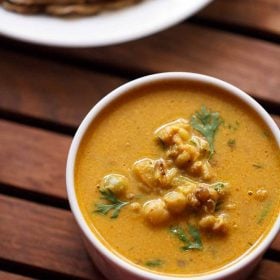
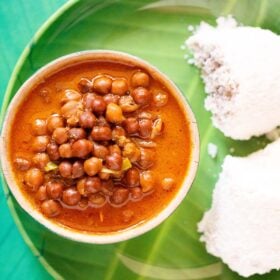
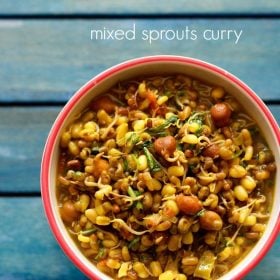
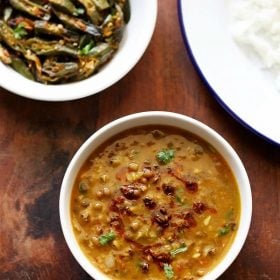
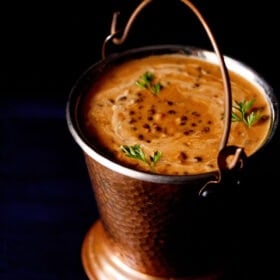
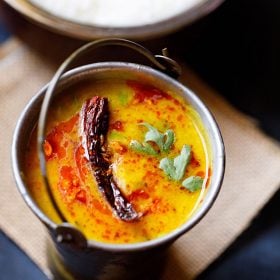
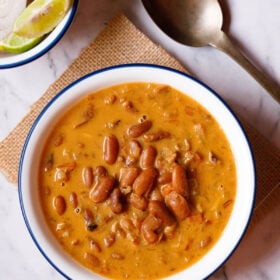
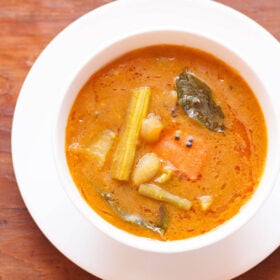








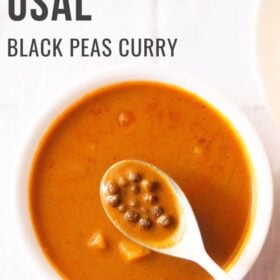
What substitution would you suggest if I cannot add coconut due to medical issues? Or what changes should I make to the recipe if I have to skip the coconut?
coconut is an essential ingredient in this recipe. so it cannot be skipped. with any other ingredient in place of coconut in the recipe, the taste and flavor will change completely.
Dear Dassana,
Thank you very much for your recipes. Tried this one also. Brilliant…..May God bless you for your sharing nature. Lots of love.
Welcome Sulata. Thanks for your best wishes and positive feedback.
I tried above recipe means malwani kala vatana it’s too good in taste thanks
thankyou indra 🙂
hi dasanna, as I wrote to u , I am from South , I don’t get black peas, we get either white or green dried ones or green peas. Please suggest an alternate. What are dagad phool, nag Keshar and tribal? Where are t hey available and how to get them in small quantities. At your convenience, please update me. I tried your poha dosa. The proportion from what I do is a little different, but enjoy trying out your proportions, a great change and I don’t feel my age. It is a therapy, I take it on my son!!!!!! God bless you and your supporting husband. DK
dk ji, you can use both dried white or green peas. you can also use cowpeas or black eyed peas. also black chickpeas or kala chana can be used. i make a similar recipe with black eyed beans. you can have a look here – https://www.vegrecipesofindia.com/chawli-usal/
dagad phool and nagkesar are spices. you can have a look at them here -https://www.vegrecipesofindia.com/wp-content/uploads/2014/07/aromatic-spices-for-goda-masala.jpg
dagad phool is a dried lichen and has a kind of a musky aroma and used in biryani masala or while making biryanis or pulao. nagkesar is a spice which is added to the masalas made in maharashtrian cuisine.
teppal or tirphal is also a spice which is easily available in goa and konkan. have a look here – https://www.vegrecipesofindia.com/wp-content/uploads/2012/07/red-chili-paste-with-sichuan-peppers.jpg
thanks dk ji from both of us. cooking is a therapy and trying out new recipes too 🙂
Thank you soooooo very much.my husband n brother in law generally despise my cooking but yesterday evening when they tasted this they had a look of deep satisfaction.they even took seconds n thirds.tha,x again for the detailed step by step guidance.
welcome nancy. thats good to know. thanks for sharing your experience. do try some more recipes.
Dassana you are fantastic with step by step instructions, even a novice can follow it, thanks for sharing this.
thanks neela. i do try my best to present the instructions in a simple manner for everybody to understand.
Thanks….
Do you know where can I find the Vade flour in US? I stay in Los Angeles, CA. Not sure if any store carries it. Let me know if anywhere I can buy it online or how to make Vade flour at home easily …
hi jitendra,
i do not know where in US one will get the vade flour.
I love eating this traditional dish made by my mom…and its the exact way she makes it…. hope every one will enjoy this tradition receipe!!!
I loved this receipe since my childhood. Thanx for posting this recipe.
thank you shweta
Many thanx ,
After almost after 20 years I got this recipe
welcome uday…… do try the recipe at home…..
excellent ,perfect to the tee.
enjoyed every bit of making it and relished it.
thanks you swati…. this is one recipe that i have also always relished when my mother would make it